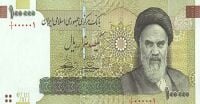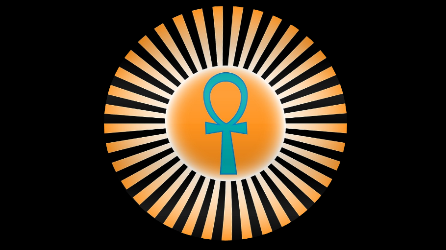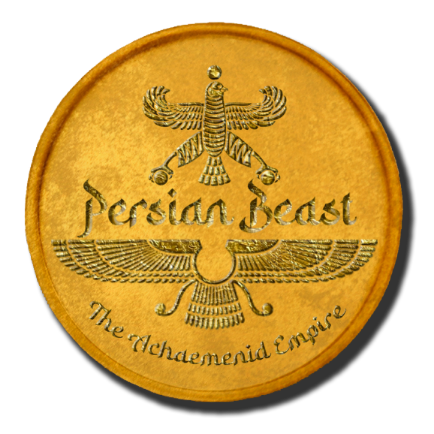| National Factbook |
| Flag: |

|
| Nation Name: |
Persis |
| Leader Name: |
Cyrus the Great |
| Currency: |

Iranian Rial |
| National Animal: |

Lion |
| History: |
A bas-relief at Persepolis, depicting the united Medes and Persians
By the second millennium BC, the ancient Iranian peoples arrived in what is now Iran from the Eurasian Steppe,[76] rivaling the native settlers of the region.[77][78] As the Iranians dispersed into the wider area of Greater Iran and beyond, the boundaries of modern-day Iran were dominated by Median, Persian, and Parthian tribes.
From the late tenth to the late seventh century BC, the Iranian peoples, together with the "pre-Iranian" kingdoms, fell under the domination of the Assyrian Empire, based in northern Mesopotamia.[79][page needed] Under king Cyaxares, the Medes and Persians entered into an alliance with Babylonian ruler Nabopolassar, as well as the fellow Iranian Scythians and Cimmerians, and together they attacked the Assyrian Empire. The civil war ravaged the Assyrian Empire between 616 and 605 BC, thus freeing their respective peoples from three centuries of Assyrian rule.[79] The unification of the Median tribes under king Deioces in 728 BC led to the foundation of the Median Empire which, by 612 BC, controlled almost the entire territory of present-day Iran and eastern Anatolia.[80] This marked the end of the Kingdom of Urartu as well, which was subsequently conquered and dissolved.[81][82]
Tomb of Cyrus the Great, founder of the Achaemenid Empire, in Pasargadae
In 550 BC, Cyrus the Great, the son of Mandane and Cambyses I, took over the Median Empire, and founded the Achaemenid Empire by unifying other city-states. The conquest of Media was a result of what is called the Persian Revolt. The brouhaha was initially triggered by the actions of the Median ruler Astyages, and was quickly spread to other provinces as they allied with the Persians. Later conquests under Cyrus and his successors expanded the empire to include Lydia, Babylon, Egypt, parts of the Balkans and Eastern Europe proper, as well as the lands to the west of the Indus and Oxus rivers.
539 BC was the year in which Persian forces defeated the Babylonian army at Opis, and marked the end of around four centuries of Mesopotamian domination of the region by conquering the Neo-Babylonian Empire. Cyrus entered Babylon and presented himself as a traditional Mesopotamian monarch. Subsequent Achaemenid art and iconography reflect the influence of the new political reality in Mesopotamia.
The Achaemenid Empire (550 BC–330 BC) around the time of Darius the Great and Xerxes I
The Parthian Empire (247 BC–224 AD) in 94 BC at its greatest extent, during the reign of Mithridates II
At its greatest extent, the Achaemenid Empire included territories of modern-day Iran, Republic of Azerbaijan (Arran and Shirvan), Armenia, Georgia, Turkey (Anatolia), much of the Black Sea coastal regions, northeastern Greece and southern Bulgaria (Thrace), northern Greece and North Macedonia (Paeonia and Macedon), Iraq, Syria, Lebanon, Jordan, Israel and the Palestinian territories, all significant population centers of ancient Egypt as far west as Libya, Kuwait, northern Saudi Arabia, parts of the United Arab Emirates and Oman, Pakistan, Afghanistan, and much of Central Asia, making it the largest empire the world had yet seen.[20]
It is estimated that in 480 BC, 50 million people lived in the Achaemenid Empire.[83][84] The empire at its peak ruled over 44% of the world's population, the highest such figure for any empire in history.[85]
The Achaemenid Empire is noted for the release of the Jewish exiles in Babylon,[86] building infrastructures such as the Royal Road and the Chapar (postal service), and the use of an official language, Imperial Aramaic, throughout its territories.[20] The empire had a centralized, bureaucratic administration under the emperor, a large professional army, and civil services, inspiring similar developments in later empires.[87][88]
Eventual conflict on the western borders began with the Ionian Revolt, which erupted into the Greco-Persian Wars and continued through the first half of the fifth century BC, and ended with the withdrawal of the Achaemenids from all of the territories in the Balkans and Eastern Europe proper.[89]
In 334 BC, Alexander the Great invaded the Achaemenid Empire, defeating the last Achaemenid emperor, Darius III, at the Battle of Issus. Following the premature death of Alexander, Iran came under the control of the Hellenistic Seleucid Empire. In the middle of the second century BC, the Parthian Empire rose to become the main power in Iran, and the century-long geopolitical arch-rivalry between the Romans and the Parthians began, culminating in the Roman–Parthian Wars. The Parthian Empire continued as a feudal monarchy for nearly five centuries, until 224 CE, when it was succeeded by the Sasanian Empire.[90] Together with their neighboring arch-rival, the Roman-Byzantines, they made up the world's two most dominant powers at the time, for over four centuries.[21][22]
The Sasanians established an empire within the frontiers achieved by the Achaemenids, with their capital at Ctesiphon. Late antiquity is considered one of Iran's most influential periods, as under the Sasanians their influence reached the culture of ancient Rome (and through that as far as Western Europe),[91][92] Africa,[93] China, and India,[94] and played a prominent role in the formation of the medieval art of both Europe and Asia.[95]
Most of the era of the Sasanian Empire was overshadowed by the Roman–Persian Wars, which raged on the western borders at Anatolia, the Western Caucasus, Mesopotamia, and the Levant, for over 700 years. These wars ultimately exhausted both the Romans and the Sasanians and led to the defeat of both by the Muslim invasion.[citation needed]
Throughout the Achaemenid, Parthian, and Sasanian eras, several offshoots of the Iranian dynasties established eponymous branches in Anatolia and the Caucasus, including the Pontic Kingdom, the Mihranids, and the Arsacid dynasties of Armenia, Iberia (Georgia), and Caucasian Albania (present-day Republic of Azerbaijan and southern Dagestan) |
| Geography |
| Continent: |
Asia |
| Land Area: |
180,246.08 sq. km |
| Terrain: |
Mount Damavand, the Middle East's highest peak, is located in Amol, Mazandaran.[202]
Iran has an area of 1,648,195 km2 (636,372 sq mi).[3]It is the fourth-largest country entirely in Asia and the second-largest country in Western Asia behind Saudi Arabia. It lies between latitudes 24° and 40° N, and longitudes 44° and 64° E. It is bordered to the northwest by Armenia (35 km or 22 mi), the Azeri exclave of Nakhchivan (179 km or 111 mi),[203] and the Republic of Azerbaijan (611 km or 380 mi); to the north by the Caspian Sea; to the northeast by Turkmenistan (992 km or 616 mi); to the east by Afghanistan (936 km or 582 mi) and Pakistan (909 km or 565 mi); to the south by the Persian Gulf and the Gulf of Oman; and to the west by Iraq (1,458 km or 906 mi) and Turkey (499 km or 310 mi).
Iran is located in a seismically active area.[204] On average, an earthquake of magnitude seven on the Richter scale occurs once every ten years.[205] Most earthquakes are shallow-focus and can be very devastating, such as the tragic 2003 Bam earthquake.
Iran consists of the Iranian Plateau, with the exception of the coasts of the Caspian Sea and Khuzestan. It is one of the world's most mountainous countries, its landscape dominated by rugged mountain ranges that separate various basins or plateaus from one another. The populous western part is the most mountainous, with ranges such as the Caucasus, Zagros, and Alborz, the last containing Mount Damavand, Iran's highest point at 5,610 m (18,406 ft), which is also the highest mountain in Asia west of the Hindu Kush.
The northern part of Iran is covered by the lush lowland Caspian Hyrcanian mixed forests, located near the southern shores of the Caspian Sea. The eastern part consists mostly of desert basins, such as the Kavir Desert, which is the country's largest desert, and the Lut Desert, as well as some salt lakes. Iran had a 2019 Forest Landscape Integrity Index mean score of 7.67/10, ranking it 34th globally out of 172 countries.[206] The only large plains are found along the coast of the Caspian Sea and at the northern end of the Persian Gulf, where the country borders the mouth of the Arvand river. Smaller, discontinuous plains are found along the remaining coast of the Persian Gulf, the Strait of Hormuz, and the Gulf of Oman. |
| Highest Peak: |
Mt. Damavand,
5,671 meters
|
| Lowest Valley: |
,
0 meters
|
| Climate: |
Having 11 climates out of the world's 13, Iran's climate is diverse,[207] ranging from arid and semi-arid, to subtropical along the Caspian coast and the northern forests.[208] On the northern edge of the country (the Caspian coastal plain), temperatures rarely fall below freezing and the area remains humid for the rest of the year. Summer temperatures rarely exceed 29 °C (84.2 °F).[209][210] Annual precipitation is 680 mm (26.8 in) in the eastern part of the plain and more than 1,700 mm (66.9 in) in the western part. Gary Lewis, the United Nations Resident Coordinator for Iran, has said that "Water scarcity poses the most severe human security challenge in Iran today".[211]
To the west, settlements in the Zagros basin experience lower temperatures, severe winters with below zero average daily temperatures and heavy snowfall. The eastern and central basins are arid, with less than 200 mm (7.9 in) of rain, and have occasional deserts.[212] Average summer temperatures rarely exceed 38 °C (100.4 °F).[209] The coastal plains of the Persian Gulf and Gulf of Oman in southern Iran have mild winters, and very humid and hot summers. The annual precipitation ranges from 135 to 355 mm (5.3 to 14.0 in).[209]
Despite climate change in the region, Iran is by far the largest of the few countries in the world which have not ratified the Paris Agreement.[213]
|
| People & Society |
| Population: |
11,398,383 people |
| Demonym: |
|
| Demonym Plural: |
|
| Ethnic Groups: |
Persian - 65.0%
Turkic - 15.0%
Kurdish - 11.0% |
| Languages: |
Farsi - 70.0%
Azeri - 15.0%
Kurdish - 11.0% |
| Religions: |
Shia Islam - 90.0%
Sunni islam - 5.0%
Christianity - 3.0% |
| Health |
| Life Expectancy: |
78 years |
| Obesity: |
13% |
| Alcohol Users: |
20% |
| Tobacco Users: |
27% |
| Cannabis Users: |
12% |
| Hard Drug Users: |
4% |
| Economy |
| Description: |
Iran's economy is a mixture of central planning, state ownership of oil and other large enterprises, village agriculture, and small-scale private trading and service ventures.In 2017, GDP was $427.7 billion ($1.631 trillion at PPP), or $20,000 at PPP per capita. Iran is ranked as a lower-middle income economy by the World Bank. In the early 21st century, the service sector contributed the largest percentage of the GDP, followed by industry (mining and manufacturing) and agriculture.
The Central Bank of the Islamic Republic of Iran is responsible for developing and maintaining the Iranian rial, which serves as the country's currency. The government does not recognize trade unions other than the Islamic labour councils, which are subject to the approval of employers and the security services. The minimum wage in June 2013 was 487 million rials a month ($134). Unemployment has remained above 10% since 1997, and the unemployment rate for women is almost double that of the men.
In 2006, about 45% of the government's budget came from oil and natural gas revenues, and 31% came from taxes and fees.[325] As of 2007, Iran had earned $70 billion in foreign-exchange reserves, mostly (80%) from crude oil exports. Iranian budget deficits have been a chronic problem, mostly due to large-scale state subsidies, that include foodstuffs and especially gasoline, totaling more than $84 billion in 2008 for the energy sector alone. In 2010, the economic reform plan was approved by parliament to cut subsidies gradually and replace them with targeted social assistance. The objective is to move towards free market prices in a five-year period and increase productivity and social justice.
The administration continues to follow the market reform plans of the previous one, and indicates that it will diversify Iran's oil-reliant economy. Iran has also developed a biotechnology, nanotechnology, and pharmaceutical industry. However, nationalized industries such as the bonyads have often been managed badly, making them ineffective and uncompetitive with years. Currently, the government is trying to privatize these industries, and, despite successes, there are still several problems to be overcome, such as the lagging corruption in the public sector and lack of competitiveness.
Iran has leading manufacturing industries in the fields of automobile manufacture, transportation, construction materials, home appliances, food and agricultural goods, armaments, pharmaceuticals, information technology, and petrochemicals in the Middle East. According to the 2012 data from the Food and Agriculture Organization, Iran has been among the world's top five producers of apricots, cherries, sour cherries, cucumbers and gherkins, dates, eggplants, figs, pistachios, quinces, walnuts, and watermelons.
Economic sanctions against Iran, such as the embargo against Iranian crude oil, have injured the economy. In 2015, Iran and the P5+1 reached a deal on the nuclear program that removed the main sanctions pertaining to Iran's nuclear program by 2016. According to the BBC, renewed U.S. sanctions against Iran "have led to a sharp downturn in Iran's economy, pushing the value of its currency to record lows, quadrupling its annual inflation rate, driving away foreign investors, and triggering protests. |
| Average Yearly Income: |
$249.98 |
| Gross Domestic Product (GDP): |
$26,698,115,599.00 |
| GDP per Capita: |
$2,342.27 |
| Gross National Income (GNI): |
$17,698,728,455.00 |
| Industries: |
|
| Military |
| History: |
The Islamic Republic of Iran has two types of armed forces: the regular forces of the Army, the Air Force, and the Navy, and the Revolutionary Guards, totaling about 545,000 active troops. Iran also has around 350,000 Reserve Force, totaling around 900,000 trained troops.[291]
The government of Iran has a paramilitary, volunteer militia force within the Islamic Revolutionary Guard Corps, called the Basij, which includes about 90,000 full-time, active-duty uniformed members. Up to 11 million men and women are members of the Basij who could potentially be called up for service. In 2007, Iran's military spending represented 2.6% of the GDP or $102 per capita, the lowest figure of the Persian Gulf nations.[292] Iran's military doctrine is based on deterrence.[293] In 2014, the country spent $15 billion on arms, while the states of the Gulf Cooperation Council spent eight times more.[294]
The government of Iran supports the military activities of its allies in Syria, Iraq, and Lebanon (Hezbollah) with military and financial aid.[295] Iran and Syria are close strategic allies, and Iran has provided significant support for the Syrian Government in the Syrian Civil War.[296] According to some estimates, Iran controlled over 80,000 pro-Assad Shi'ite fighters in Syria.[296][297]
Since the 1979 Revolution, to overcome foreign embargoes, the government of Iran has developed its own military industry, produced its own tanks, armored personnel carriers, missiles, submarines, military vessels, missile destroyer, radar systems, helicopters, and fighter planes.[298] In recent years, official announcements have highlighted the development of weapons such as the Hoot, Kowsar, Zelzal, Fateh-110, Shahab-3, Sejjil, and a variety of unmanned aerial vehicles (UAVs).[299] Iran has the largest and most diverse ballistic missile arsenal in the Middle East.[300] The Fajr-3, a liquid fuel missile with an undisclosed range which was developed and produced domestically, is currently the most advanced ballistic missile of the country.
In June 1925, Reza Shah introduced conscription law at National Consultative Majlis. At that time, every male person who had reached 21 years old must serve in the military for two years. The conscription exempted women from military service after 1979 revolution. Iranian constitution obliges all men of 18 years old and higher to serve on military or police bases. They cannot leave the country or be employed without completion of the service period.[citation needed] The period varies from 18 to 24 months. |
| Soldiers: |
0 |
| Tanks: |
16,750 |
| Aircraft: |
2,475 |
| Ships: |
0 |
| Missiles: |
0 |
| Nuclear Weapons: |
1 |
| Last Updated: 12/22/2022 07:20 pm |















